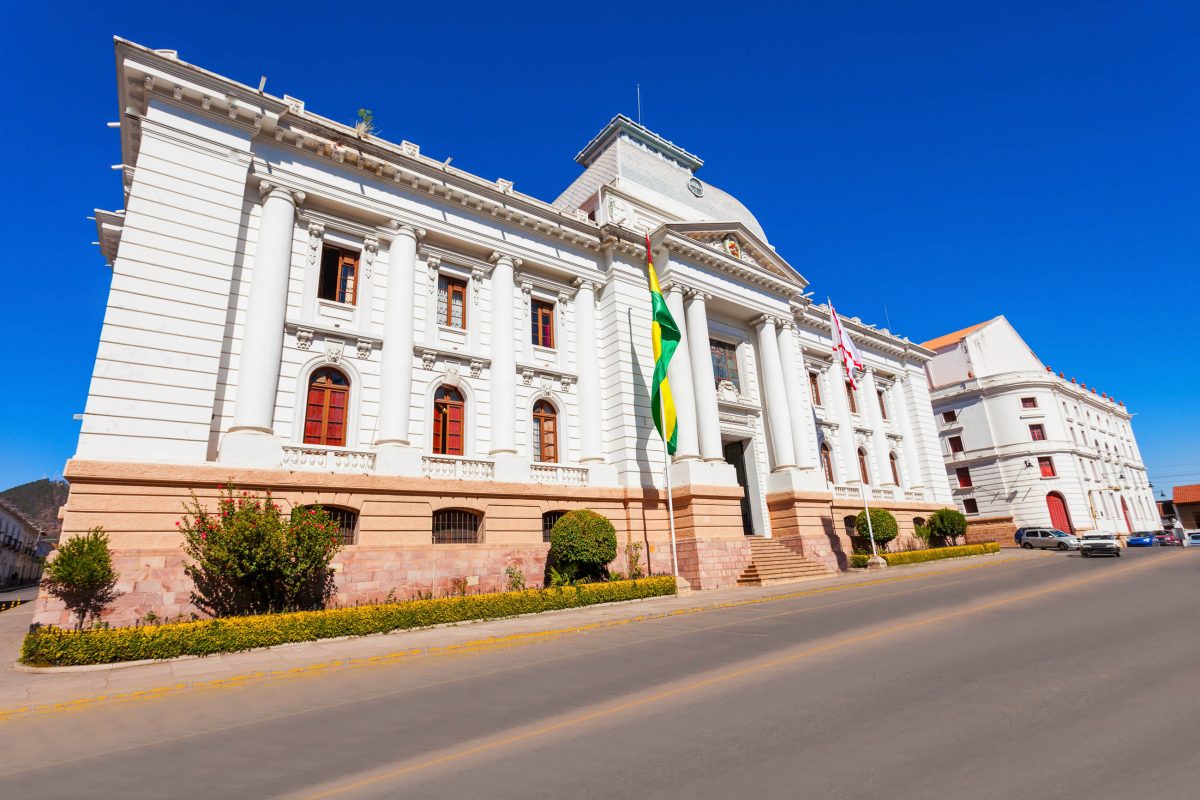Der Parque Bolivar ist der größte und wohl auch schönste Park von Sucre. Die Heimat des Obersten Gerichtshofs von Sucre lockt mit Pariser-Flair, Picknickmöglichkeiten und einem musikalischen Springbrunnen Groß und Klein in seine grüne Oase.
Wer in der Weißen Stadt Boliviens auf der Suche nach Entspannung im Grünen ist, wird unweigerlich im Parque Bolivar landen. Der größte und wohl auch schönsten Park der Stadt zählt zu unseren Top 10 Sehenswürdigkeiten von Sucre. Hier finden Familien auf weiten Rasenflächen Idylle für ein Picknick, Verliebte romantische Verstecke unter uralten Bäumen und Sportler auf baumbestandenen Boulevards ausreichend Platz zum Joggen und Radeln.
Der Parque Bolivar liegt 4 Blocks vom Plaza 25 de Mayo entfernt und erstreckt sich vom schneeweißen Regierungspalast bis zur Estacion Aniceto Arce, einst eine der am meisten frequentierten Bahnhöfe Lateinamerikas. Er wurde als Schlosspark des Glorieta-Palastes angelegt.
Sehenswürdigkeiten im Parque Bolivar
Der gut gepflegte Parque Bolivar ist nicht nur Sucres erste Adresse für Erholung und Entspannung, sondern hält entlang seiner breiten Alleen auch einige sehenswerte Überraschungen bereit.
An den Wochenenden ist hier einiges los und Straßenverkäufer mischen sich unter die Jogger und Spaziergänger. Zu kaufen gibt es Getränke, kalte und warme Snacks, Eiscreme, Zuckerwatte, Kunsthandwerk und Souvenirs zu Spottpreisen. Picknickbänke und Kinderspielplätze komplettieren das umfassende Freizeitangebot des Bolivar-Parks.
Oberster Gerichtshof

Das neoklassizistische Gebäude direkt am Parque Bolivar beherbergt seit dem 25. Mai 1945 den Obersten Gerichtshof. Zuvor war es ein Kloster des Dominikaner-Ordens. Gemeinsam mit dem Casa de la Libertad ist der schneeweiße Bau der wohl geschichtsträchtigste Ort der Stadt.
Der Oberste Gerichtshof, der Corte Suprema de Justicia, von Bolivien wurde am 16. Juli 1827 vom ersten Präsidenten Boliviens, Mariscal Antonio José de Sucre gegründet, jenem General, nach dem auch die Stadt benannt ist. Damals entstand aus der von Spanien regierten Real Audiencia von Charcas der unabhängige Staat Bolivien.
Die Judikative von Bolivien ist der Grund, warum sich eine der schönsten Städte des Landes immer noch Hauptstadt nennen darf, obwohl die Staatsregierung inklusive Exekutive und Legislative längst nach La Paz übersiedelt ist.
Besuch des Obersten Gerichtshofs in Sucre

Im Zuge von Führungen kann das Justizgebäude von Sucre auch von innen besichtigt werden. In der Eingangshalle erinnert eine Statue des bedeutenden Bildhauers Hugo Barrenechea an den berühmten Juristen Don Pantaleón Dalence. Der zweimalige Präsident des Obersten Gerichtshofs gilt auch als „Vater der bolivianischen Justiz“.
Neben dem Verhandlungssaal ist im Erdgeschoß noch der Ehrensaal sehenswert. Hier sind neben anderen berühmten Politikern auch Südamerikas berühmtester Freiheitskämpfer Simon Bolivar und seine Generäle José Antonio de Sucre und Andrés de Santa Cruz auf drei großen Gemälden an der Rückwand zu sehen.
Im zweiten Stock beeindruckt der elegante Spiegelsaal mit einem Dutzend goldgerahmter Spiegel Touristen und Delegationen aus der ganzen Welt. Die wunderschönen Glasfenster wurden von Melchor de Pesoa als Symbole der Gerechtigkeit gestaltet.
Ebenfalls im zweiten Stock befindet sich die 1945 von Dr. Edgar Oblitas Fernández eröffnete Zentralbibliothek des Obersten Gerichtshofs, deren dokumentarische Schätze zu den historisch wertvollsten bibliographischen Sammlungen Boliviens zählen.
Eiffelturm und Triumphbogen von Sucre
Der am 25. Mai 1909 eröffnete Eiffelturm von Sucre sieht zwar nicht exakt so aus, wie sein berühmter Zwilling in Paris, verdient seinen Namen aber dennoch, denn auch er wurde von Gustav Eiffel entworfen. Nicht nur das, der zweistöckige Turm inmitten des Bolivar-Parks besteht sogar aus dem Material, welches beim Pariser Eiffelturm übrig geblieben war.
Der zuerst als Wetterstation genutzte Eiffelturm wurde 1925, zum 100jährigen Jubiläum des unabhängigen Staates Bolivien, an seinen heutigen Platz im Parque Bolivar übersiedelt. Heute ist er nur mehr eine Touristenattraktion, die über eine eiserne Wendeltreppe bestiegen werden kann und einen schönen Rundumblick über den Park bietet.
Auch ein Duplikat des Pariser Triumphbogens und eine Statue von Freiheitskämpfer Simon Bolivar und Boliviens ehemaligen Präsidenten Aniceto Arce sind im Parque Bolivar zu finden.
Fuente del Bicentenario
Der 200-Jahr-Springbrunnen im Süden des Parks wurde zur Erinnerung an den Aufstand von 1809 von der Zementfirma Fancesa gespendet, die auch die berühmten Dinosaurierspuren bei Sucre entdeckt hat. Der Springbrunnen ist vor allem an Freitag-, Samstag- und Sonntagabenden einen Besuch wert. Dann wird er mit einer Show aus Licht und nationalen und internationalen Songs zum musikalischen Springbrunnen.
La Piscina del Parque Simon Bolivar
Das öffentliche Schwimmbecken im Parque Bolivar ist mit seinen 50 Metern Länge auch für Sportschwimmer geeignet und wird immer wieder von Schwimmschulen genutzt. Mit Sauna und Snack Bar ist es an heißen Tagen ein beliebtes Ziel für Familien und Hobby-Schwimmer.
Weiterführende Links:





